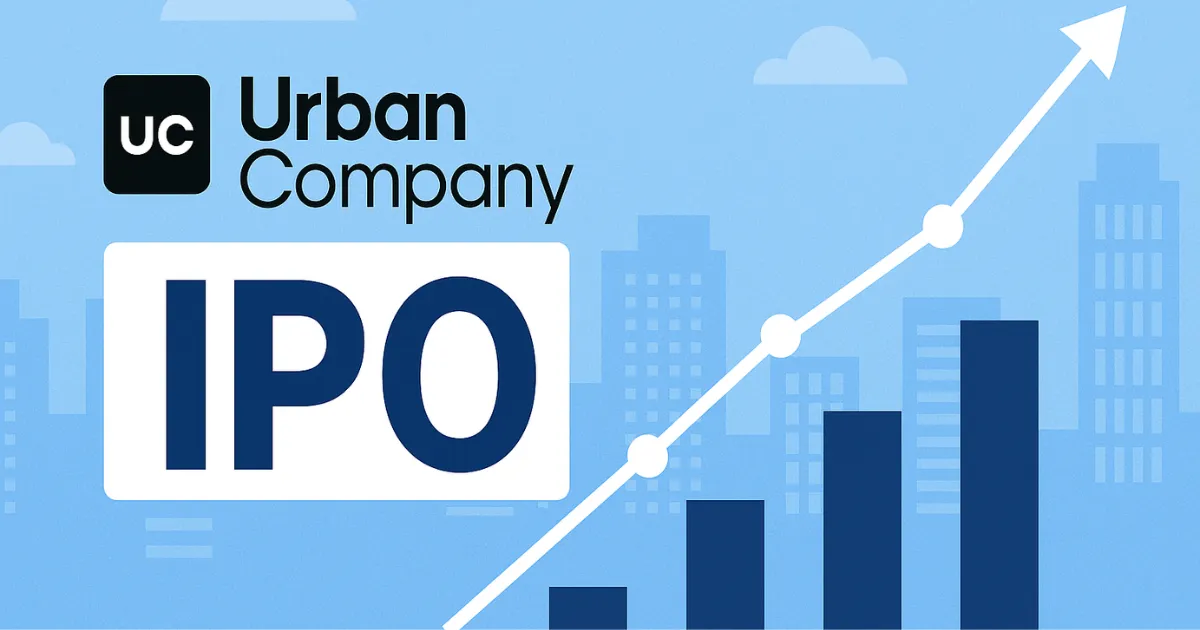Urban Company IPO Listing LIVE:- The buzz around Urban Company IPO Listing LIVE: Stock Debuts at 57.5% Premium, Gains 1% on NSE – What’s Next? has taken the Indian stock market by storm. Investors, both retail and institutional, are eager to understand the implications of Urban Company’s stellar debut on September 17, 2025, and what lies ahead for this tech-driven home services giant. With a listing premium of 57.5% and a post-listing gain of 1% on the NSE, Urban Company has set a high benchmark for IPOs in 2025.
This article dives deep into the IPO’s performance, the company’s growth prospects, market dynamics, and expert insights to help investors make informed decisions. Whether you’re an allotted investor or considering entering the stock, we’ll explore what’s next for Urban Company and how it fits into the broader market landscape.
Urban Company IPO Listing LIVE: Urban Company’s Blockbuster IPO Debut
A Stellar Listing Performance
Urban Company, India’s leading tech-enabled home services platform, made headlines with its IPO debut on September 17, 2025. The stock listed at ₹162.25 on the National Stock Exchange (NSE), reflecting a 57.5% premium over its issue price of ₹103. On the Bombay Stock Exchange (BSE), it opened at ₹161, a 56% gain. This marked the best mainboard IPO listing of 2025, surpassing Aditya Infotech’s 49.78% premium. Post-listing, the stock surged to an intra-day high of ₹179 on the NSE, a 73.8% jump, and hit ₹171.90 on the BSE, showcasing strong investor confidence.
Why the Hype?
The IPO, valued at ₹1,900 crore, was subscribed 108.98 times, receiving bids for over 1.14 lakh crore equity shares. This overwhelming response was driven by Urban Company’s strong brand recall, first-mover advantage in the fragmented home services sector, and its scalable tech-driven model. The company’s operations span 51 cities in India, with an international presence in the UAE, Singapore, and Saudi Arabia, positioning it as a leader in a market projected to reach $97.4 billion by 2029.
Key IPO Details
To understand the scale of Urban Company’s IPO, let’s break down its structure:
| Aspect | Details |
|---|---|
| IPO Size | ₹1,900 crore |
| Fresh Issue | 4.58 crore shares (₹472 crore) |
| Offer for Sale (OFS) | 13.86 crore shares (₹1,428 crore) |
| Price Band | ₹98–₹103 per share |
| Lot Size | 145 shares (minimum investment: ₹14,935 at upper price band) |
| Subscription Period | September 10–12, 2025 |
| Allotment Date | September 15, 2025 |
| Listing Date | September 17, 2025 |
| Lead Managers | Kotak Mahindra Capital, Morgan Stanley India, Goldman Sachs, JM Financial |
| Registrar | MUFG Intime India |
The IPO’s allocation favored Qualified Institutional Buyers (QIBs) at 74.9%, with Non-Institutional Investors (NIIs) and Retail Individual Investors (RIIs) receiving 14.98% and 9.99%, respectively. A small portion (0.13%) was reserved for employees at a ₹9 discount.
Urban Company: Behind the Urban Company IPO
A Tech-Driven Home Services Pioneer
Founded in 2014 by Abhiraj Singh Bhal, Varun Khaitan, and Raghav Chandra, Urban Company (formerly UrbanClap) connects consumers with trained professionals for services like cleaning, plumbing, beauty, and appliance repair. Operating in 59 cities globally, it leverages a user-friendly app and transparent pricing to dominate the fragmented home services market. Backed by marquee investors like Accel, Tiger Global, and Naspers, Urban Company has built a scalable model that prioritizes quality and accessibility.
Financial Performance
Urban Company’s financials reflect robust growth and improving profitability:
| Metric | FY24 | FY25 |
|---|---|---|
| Revenue | ₹830 crore | ₹1,144.5 crore |
| Revenue Growth | – | 38% |
| Net Profit | Loss of ₹90 crore | Profit of ₹240 crore |
| Valuation (Post-IPO) | – | ₹14,790 crore |
The swing to profitability in FY25 was aided by a one-time non-cash deferred tax asset recognition of ₹211 crore, raising some concerns about sustainability. However, the company’s 38% revenue growth underscores its strong market position.
Urban Company IPO Listing LIVE: Growth Strategy
Urban Company aims to:
- Expand to 200 cities in India by FY30.
- Strengthen its international presence in the UAE, Singapore, and Saudi Arabia.
- Invest in technology and cloud infrastructure (₹190 crore from IPO proceeds).
- Enhance marketing efforts (₹90 crore) and lease payments (₹75 crore).
These initiatives position Urban Company to capitalize on the growing demand for tech-enabled home services.
What Drove the 57.5% Listing Premium?
Strong Investor Demand
The IPO’s subscription figures tell a story of investor enthusiasm:
- QIBs: Subscribed 147.35 times.
- NIIs: Subscribed 77.82 times.
- Retail Investors: Subscribed 41.49 times.
This demand was fueled by Urban Company’s leadership in a fragmented sector, its tech-driven model, and a positive market sentiment. The grey market premium (GMP) of ₹51 before listing indicated a potential listing price of ₹154, but the actual debut exceeded expectations.
Urban Company IPO: Market Sentiment and Timing
The IPO launched amid a favorable market environment, with the BSE Sensex and NSE Nifty trading 0.3% higher on listing day. The broader IPO market in India is also heating up, with 15 mainboard issues worth ₹10,000 crore slated for the festive season. Urban Company’s timing capitalized on this bullish sentiment, enhancing its listing performance.
Analyst Expectations
Analysts like Prashanth Tapse from Mehta Equities predicted 40–50% listing gains, citing Urban Company’s strong brand and first-mover advantage. The actual 57.5% premium outperformed these forecasts, reflecting investor confidence in the company’s long-term potential.
Post-Listing Performance: A 1% Gain on NSE
Intra-Day Movements
Post-listing, Urban Company’s stock gained 1% on the NSE, reaching ₹176 intra-day before settling at ₹178.3 by midday. On the BSE, it hit ₹177, reflecting sustained investor interest. These gains, while modest compared to the listing premium, indicate stability and potential for further growth.
Market Capitalization
At listing, Urban Company’s market capitalization stood at ₹23,118 crore, making it a significant player in the tech-driven services sector. The stock’s ability to hold above ₹170 suggests investor confidence in its growth trajectory.
What’s Next for Urban Company?
Short-Term Outlook
In the near term, Urban Company’s stock is likely to remain volatile as investors assess its post-listing performance. Analysts recommend a “hold” strategy for allotted investors, given the stock’s premium valuation (P/E of 54x adjusted earnings). Non-allotted investors are advised to adopt a “wait-and-watch” approach, looking for potential dips as entry points. The festive season and upcoming IPOs may influence market dynamics, potentially impacting Urban Company’s stock price.
Long-Term Growth Potential
Urban Company’s long-term prospects are promising due to:
- Market Leadership: As the only organized player in India’s tech-driven home services market, Urban Company enjoys a first-mover advantage.
- Scalable Model: Its platform-based approach allows rapid expansion without significant capital expenditure.
- Growing Demand: The home services market is projected to grow to $97.4 billion by 2029, driven by rising household incomes and urbanization.
- International Expansion: Presence in the UAE, Singapore, and Saudi Arabia positions Urban Company for global growth.
However, challenges like competition from unorganized players, gig worker dependency, and regulatory risks in the gig economy could impact margins and operations.
Risks to Watch
Investors should be mindful of:
- Valuation Concerns: At 60x P/E and 12.9x Price-to-Sales, Urban Company’s valuation is stretched compared to peers.
- Profitability Questions: The FY25 profit was boosted by a one-time tax credit, raising doubts about sustainable earnings.
- Operational Risks: Dependence on gig workers and potential regulatory changes in the gig economy could affect consistency and margins.
- Competition: Unorganized players and regional competitors like Housejoy and Sulekha pose threats.
Case Study: Comparing Urban Company with Aditya Infotech
To contextualize Urban Company’s debut, let’s compare it with Aditya Infotech, which held the record for 2025’s best IPO listing until September 17:
| Metric | Urban Company | Aditya Infotech |
|---|---|---|
| Listing Premium | 57.5% | 49.78% |
| Issue Price | ₹103 | Not specified |
| Listing Price (NSE) | ₹162.25 | Not specified |
| Market Cap (Post-IPO) | ₹23,118 crore | Not specified |
| Subscription Rate | 108.98x | Not specified |
Urban Company’s higher listing premium and subscription rate reflect stronger investor confidence, driven by its tech-driven model and broader market appeal. However, Aditya Infotech’s focus on video security products caters to a niche market, potentially limiting its scalability compared to Urban Company’s diverse service offerings.
Urban Company IPO: Expert Insights and Analyst Recommendations
Prashanth Tapse, Mehta Equities
Prashanth Tapse, Senior Vice President (Research) at Mehta Equities, emphasizes Urban Company’s long-term potential: “Despite a premium valuation, Urban Company’s leadership in a fragmented sector and strong brand recall make it a compelling long-term investment. Allotted investors should hold, while others should wait for a post-listing dip.”
Financial Sarthis
SEBI-registered Financial Sarthis highlight valuation concerns: “At 60x P/E, Urban Company is priced higher than peers. The one-time tax credit in FY25 raises questions about sustainable profitability. Investors should approach with caution.”
Ishank Gupta, Deven Choksey
Ishank Gupta notes that the IPO’s pricing at ₹98–₹103 is “fairly valued” compared to rivals, given Urban Company’s revenue growth and market dominance.
How Urban Company Fits into India’s IPO Market
India’s IPO market is booming, with 2025 shaping up as a landmark year. Urban Company’s debut aligns with a wave of high-profile IPOs, including Groww, ZappFresh, and Hero Motors. The festive season is expected to see 15 mainboard issues worth ₹10,000 crore, reflecting growing investor appetite. Urban Company’s success could set the tone for tech-driven startups like Lenskart and Meesho, which are also eyeing public listings.
FAQs About Urban Company IPO Listing
1. What was the listing premium of Urban Company IPO?
Urban Company’s IPO made a remarkable debut on September 17, 2025, listing on the BSE and NSE at a significant premium. Reports indicate the shares debuted at approximately ₹163, reflecting a listing premium of nearly 60% over the issue price of ₹103. This strong performance was driven by high investor enthusiasm, as evidenced by the grey market premium (GMP) surging to ₹70 before listing, suggesting a potential listing price around ₹173.
The IPO’s oversubscription rate of 103.63 times, particularly from qualified institutional buyers (147.20 times), further fueled the bullish sentiment. Analysts attribute the premium to Urban Company’s dominant position in the tech-driven home services market and its recent profitability, with FY25 revenue of ₹1,144 crore and a profit of ₹240 crore. However, GMP is not an official indicator, and actual listing performance can vary due to market conditions.
2. Why did Urban Company IPO perform so well?
Urban Company’s IPO saw exceptional performance due to several key factors. The issue was subscribed 103.63 times, reflecting robust demand from institutional (147.20 times), non-institutional (74.04 times), and retail investors (39.25 times). This enthusiasm stemmed from Urban Company’s position as India’s leading tech-enabled home services platform, operating in 51 cities with a strong brand recall. Its recent financial turnaround, posting a ₹240 crore profit in FY25 compared to a ₹93 crore loss in FY24, bolstered investor confidence.
The grey market premium, which climbed to ₹70 (68% above the ₹103 issue price), signaled strong pre-listing optimism. Additionally, Urban Company’s innovative AI-driven service model, extensive network of 54,000+ professionals, and presence in a $59 billion under-penetrated market contributed to its appeal. Positive market sentiment and expectations of follow-on buying from investors who missed allotments further drove its success.
3. Should I hold or sell Urban Company shares post-listing?
Deciding whether to hold or sell Urban Company shares post-listing depends on your investment goals and risk tolerance. The IPO listed at a 60% premium (₹163 against ₹103), offering immediate gains for allottees. Analysts like Prashanth Tapse from Mehta Equities suggest listing gains of 40-50% or higher, driven by strong subscription and market sentiment. For short-term investors, booking profits post-listing may be appealing given the high GMP and potential volatility in a newly listed stock.
However, long-term investors might consider holding due to Urban Company’s leadership in the home services sector, 38% revenue growth in FY25 (₹1,144 crore), and expansion plans in India and international markets. Risks include high valuations (P/E of 62.42x at ₹103) and competition from unorganized players. Evaluate your portfolio strategy and monitor market trends before deciding, as share prices can fluctuate post-listing.
4. What are the risks of investing in Urban Company?
Investing in Urban Company carries several risks. Its recent profitability (₹240 crore in FY25) relies partly on a deferred tax credit (₹211.2 crore), raising concerns about sustainable earnings. The company previously reported net losses and negative cash flows, and failure to maintain revenue growth could impact financial stability. Urban Company’s reputation hinges on consistent service quality; any decline could erode customer trust and affect performance. The high valuation (P/E of 62.42x at ₹103) may deter conservative investors, as it assumes aggressive growth expectations. Retaining service professionals is critical, as their departure could disrupt operations.
The home services market, while large ($59 billion), is highly fragmented with competition from unorganized players and regional firms like Housejoy and Sulekha. Additionally, the significant offer-for-sale component (₹1,428 crore) in the IPO suggests existing investors are cashing out, potentially signaling caution. Market volatility could also affect post-listing performance.
5. What are Urban Company’s growth plans?
Urban Company aims to leverage its ₹472 crore fresh issue proceeds to fuel growth. Key plans include enhancing its technology infrastructure, investing in cloud services, and boosting marketing efforts to strengthen brand presence. The company operates in 51 cities (47 in India, plus UAE and Singapore) and plans to deepen penetration in these markets while exploring new micro-markets through its “InstaHelp” on-demand service. Urban Company is also expanding its “Native” branded hardware line, including water purifiers and smart locks, to diversify revenue.
Its AI-driven platform, which matches 54,000+ professionals to 14.5 million customers, will see further investment to improve efficiency and scalability. International expansion, including its joint venture in Saudi Arabia, is a priority to tap global demand. With the $59 billion home services market largely unorganized, Urban Company aims to capture a larger share through digitalization and professional training, ensuring standardized service delivery.
6. How does Urban Company compare to its competitors?
Urban Company stands out as India’s leading tech-driven home services platform, competing primarily with unorganized regional players and smaller organized firms like Housejoy and Sulekha. Unlike its competitors, Urban Company’s AI-powered platform connects 14.5 million customers with 54,000+ trained professionals across 51 cities, offering services like cleaning, plumbing, and beauty. Its focus on standardized training, tools, and branding for professionals gives it a competitive edge in quality and reliability.
Financially, Urban Company’s FY25 revenue of ₹1,144 crore (38% YoY growth) and profitability (₹240 crore) contrast with the fragmented, often unprofitable unorganized sector. However, competitors like Housejoy target similar urban markets, while Sulekha focuses on broader service aggregation. Urban Company’s international presence (UAE, Singapore, Saudi Arabia) and “Native” hardware line provide diversification, but its high valuation (P/E 62.42x) compared to rivals could be a concern. Its first-mover advantage and brand recall remain key differentiators.
7. How can I check my Urban Company IPO allotment status?
To check your Urban Company IPO allotment status, follow these steps. First, visit the registrar’s portal, MUFG Intime India Pvt. Ltd. Select “Urban Company IPO” from the dropdown menu, enter your PAN or application number, and click “Submit” to view your allotment details, including the number of shares credited. Alternatively, check via the BSE website by navigating to the IPO allotment page, selecting “Equity” as the issue type, choosing “Urban Company,” and entering your application number and PAN, then clicking “Search.”
The NSE portal offers a similar process under “Equity and SME IPO Bids.” Allotments were finalized on September 15, 2025, with shares credited and refunds initiated by September 16. Due to the IPO’s 103.63x oversubscription, many retail investors may not receive allotments. Always verify details through official platforms to ensure accuracy.
Conclusion
Urban Company IPO debut at a 57.5% premium and a 1% gain on the NSE marks a historic moment for India’s tech-driven home services sector. With a market cap of ₹23,118 crore and a scalable model, Urban Company IPO is well-positioned to capitalize on a $97.4 billion market by 2029. However, its premium valuation, reliance on a one-time tax credit, and operational risks warrant caution. Allotted investors should hold for long-term gains, while others should wait for potential dips.
Share your thoughts on Urban Company’s IPO in the comments, and subscribe to our newsletter for more market insights! For further reading, check our posts on India’s Booming IPO Market and Tech Startup Investment Trends. Learn more about IPO processes at SEBI’s official site or NSE’s investor portal.






